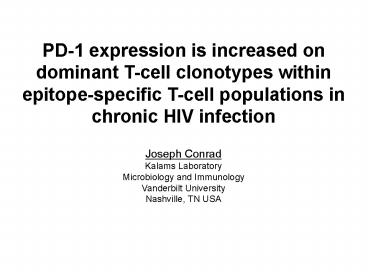Joseph Conrad - PowerPoint PPT Presentation
1 / 13
Title:
Joseph Conrad
Description:
... specific CTL expand in vitro in response to stimulation with cognate antigen ... with CFSE, and stimulated with cognate peptide in the presence of autologous APCs ... – PowerPoint PPT presentation
Number of Views:43
Avg rating:3.0/5.0
Title: Joseph Conrad
1
PD-1 expression is increased on dominant T-cell
clonotypes within epitope-specific T-cell
populations in chronic HIV infection
Joseph Conrad Kalams Laboratory Microbiology and
Immunology Vanderbilt University Nashville, TN USA
2
HIV-specific T-cells Recognize Peptides from
Viral Proteins
- Infected cells process viral peptides and
presented them in complex with surface MHC
molecules - Killing of infected cells by epitope-specific CTL
is mediated by contacts between the T-cell
receptor (TCR) and pMHC complex - Acute Infection control
- Chronic Infection exhaustion
3
PD-1 Expression in HIV Infection
- PD-1 is a co-stimulatory molecule which inhibits
antigen-receptor signaling on lymphocytes - PD-1 is upregulated and highly expressed on
T-cell populations in HIV subjects, especially
epitope-specific CTL - Despite expressing high levels of PD-1,
epitope-specific CTL expand in vitro in response
to stimulation with cognate antigen - We investigated PD-1 expression on 27
epitope-specific responses in 17 therapy naïve
subjects with varying degrees of viral control
(mean, 14000 HIV-RNA copies/ml range, 50-100000)
4
HIV-specific CTL have More PD-1 High Cells than
CD4 or CD8 Populations
PD-1 High
CD4 54 CD8 63
PD-1 High
PD-1
KF11 78
PD-1 High
n 17 subjects 27 epitopes
Epitope-specific CTL express high levels of PD-1
PD-1
5
PD-1 Expression on Epitope-specific Clonotypes
- We are evaluating the role of the T-cell receptor
(TCR) repertoire in the recognition of viral
epitopes - Through sequence analysis of TCR V-beta (TRBV)
CDR3 region, we know that epitope-specific
responses are comprised of oligo-clonal
expansions of CTL
6
PD-1 Expression on Epitope-specific Clonotypes
- We are evaluating the role of the T-cell receptor
(TCR) repertoire in the recognition of viral
epitopes - Sequence analysis of TCR V-beta (TRBV) CDR3
region, we know that epitope-specific responses
are comprised of oligo-clonal expansions of CTL - Dominant clonotype with various sub-dominant
clonotypes - Epitope-specific clonotypic populations are
identified and tracked by co-staining with
MHC-I tetramer and TRBV-specific antibodies
7
Dominant TRBV Populations Have More PD-1 High
Cells than Sub-Dominant TRBV Populations
PD-1 High
TRBV
PD-1
DomTRBV 84 Non-TRBV 69
PD-1 High
n 17 subjects 27 epitopes 6
tetramers, 1-5 tetramers/subject
Sub-dominant clonotypes express lower levels of
PD-1 than dominant clonotypes
8
Assessing Functional Differences in Clonotypic
Populations
Epitope-specific clonotypes were sorted, labeled
with CFSE, and stimulated with cognate peptide in
the presence of autologous APCs
Dominant TRBV
Sub-Dominant TRBV
CD8
9
Sub-dominant Clonotypes Produce Higher Levels of
Interferon-gamma than Dominant Clonotypes
Interferon-gamma production was measured on CFSE
CTL
Dominant TRBV
Sub-Dominant TRBV
CFSE
10
Sub-dominant Clonotypes Produce Higher Levels of
Interferon-gamma than Dominant Clonotypes
Sub-dominant clonotypes produce more IFN-gamma
11
Summary
- PD-1 is more highly expressed on epitope-specific
CTL than on CD4 or CD8 populations - PD-1 is more highly expressed on dominant
clonotypes than on sub-dominant clonotypes within
epitope-specific responses - Sub-dominant, PD-1 low clonotypes produce higher
levels of interferon-gamma by percentage and
magnitude when compared to dominant, PD-1 high
clonotypes - Data Not Shown Dominant clonotypes display
marked survival and proliferation defects in the
absence of or in low levels of stimulation
12
Conclusions
- PD-1 is more highly expressed on epitope-specific
CTL than on CD4 or CD8 populations - PD-1 is more highly expressed on dominant
clonotypes than on sub-dominant clonotypes within
epitope-specific responses - Sub-dominant, PD-1 low clonotypes produce higher
levels of interferon-gamma by percentage and
magnitude when compared to dominant, PD-1 high
clonotypes - Data Not Shown Dominant clonotypes display
marked survival and proliferation defects in the
absence of or in low levels of stimulation - PD-1 is likely upregulated on dominant
circulating clonotypes as a result of constant
immune surveillance and subsequent
antigen-induced activation - Sub-dominant clonotypes represent a potential
reservoir of relatively functional CTL capable of
responding to antigen stimulation
13
Acknowledgements
Study Cohort and Volunteers
Kalams Lab Current Spyros Kalams Brenna
Simons Louise Barnett Shelly Lorey Ramesh
Ramalingam Lakshmi Sadagopal Rita Smith Jie
Wei Former Amanda Antons Dirk Meyer-Olson Scott
Vancompernolle
DAquila Lab Lorraine Sutton Michael
Vetter Vanderbilt-Meharry CFAR Flow Cytometry
Core Sequencing Facility Grant Support HIV/AIDS
Research Training Program (HARTP) 1 T32I060571































